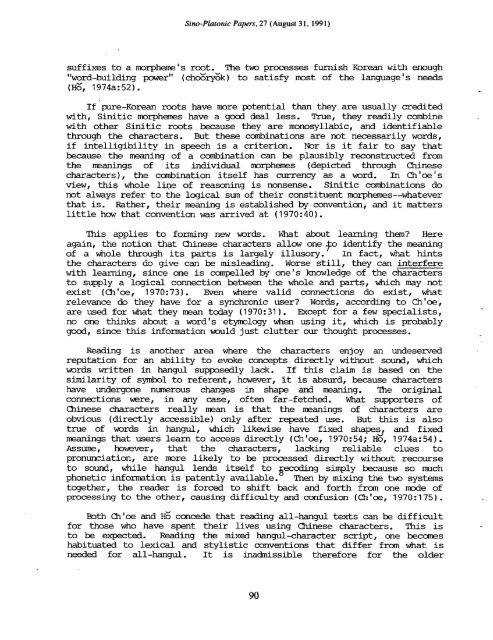Essays on Writing and Language in Honor - Sino-Platonic Papers
Essays on Writing and Language in Honor - Sino-Platonic Papers
Essays on Writing and Language in Honor - Sino-Platonic Papers
You also want an ePaper? Increase the reach of your titles
YUMPU automatically turns print PDFs into web optimized ePapers that Google loves.
Sim-Plat<strong>on</strong>ic <strong>Papers</strong>, 27 (August 3 1,199 1)<br />
suffixes to a morpheme's root, The two processes furnish Korean with emugh<br />
"word-build<strong>in</strong>g power" (chot$k)<br />
(g, 1974a: 52).<br />
to satisfy most of the language's needs<br />
C<br />
If pure-Korean roots have more potential than they are usually credited<br />
with, S<strong>in</strong>itic morphemes have a good deal less. True, they readily comb<strong>in</strong>e<br />
with other S<strong>in</strong>itic roots because they are m<strong>on</strong>osyllabic, <strong>and</strong> identifiable<br />
through the characters. But these canb<strong>in</strong>ati<strong>on</strong>s are not necessarily words,<br />
if <strong>in</strong>telligibility <strong>in</strong> speech is a criteri<strong>on</strong>. Nor is it fair to say that<br />
because the mean<strong>in</strong>g of a comb<strong>in</strong>ati<strong>on</strong> can be plausibly rec<strong>on</strong>structed from<br />
the man<strong>in</strong>gs of its <strong>in</strong>dividual mrphmes (depicted through Ch<strong>in</strong>ese<br />
characters), the canb<strong>in</strong>ati<strong>on</strong> itself has currency as a word. In Ch'oe's<br />
view, this whole l@e of reas<strong>on</strong><strong>in</strong>g is n<strong>on</strong>sense. S<strong>in</strong>itic d<strong>in</strong>ati<strong>on</strong>s do<br />
nut always refer to the logical sum of their c<strong>on</strong>stituent morphemes--whatever<br />
that is. Rather, their mean<strong>in</strong>g is established by c<strong>on</strong>ventim, <strong>and</strong> it matters<br />
little how that c<strong>on</strong>venti<strong>on</strong> was arrived at (1970:40).<br />
This applies to form<strong>in</strong>g new mrds. What about learn<strong>in</strong>g them? .Here<br />
aga<strong>in</strong>, the noti<strong>on</strong> that Wnese characters allow <strong>on</strong>e $0 identify the mean<strong>in</strong>g<br />
of a whole through its parts is largely illusory. ' In fact, what h<strong>in</strong>ts<br />
the characters do give can be mislead<strong>in</strong>g. Worse still, they can <strong>in</strong>terfere<br />
with learn<strong>in</strong>g, s<strong>in</strong>ce <strong>on</strong>e is ccmpelled by <strong>on</strong>e's knowledge of the characters<br />
to supply a -lqical c<strong>on</strong>necti<strong>on</strong> -between -the whole <strong>and</strong> parts, which may not<br />
exist (Ch'oe, 1970:73), Even where valid c<strong>on</strong>necti<strong>on</strong>s do exist, what<br />
relevance do they have for a synchr<strong>on</strong>ic user? Words, accord<strong>in</strong>g to Chloe,<br />
are used for what they man today (1970:31). Drcept for a few specialists,<br />
no <strong>on</strong>e th<strong>in</strong>ks about a word's etymology when us<strong>in</strong>g it, which is probably<br />
good, s<strong>in</strong>ce this <strong>in</strong>formati<strong>on</strong> would just clutter our thought processes,<br />
Read<strong>in</strong>g is another area where the characters enjoy an undeserved<br />
reputati<strong>on</strong> for an ability to evoke c<strong>on</strong>cepts directly without sound, which<br />
mrds written <strong>in</strong> hangul supposedly lack. If this claim is based <strong>on</strong> the<br />
similarity of symbol to referent, however, it is absurd, because characters<br />
have underg<strong>on</strong>e numerous changes <strong>in</strong> shape <strong>and</strong> mean<strong>in</strong>g. The orig<strong>in</strong>al<br />
c<strong>on</strong>necti<strong>on</strong>s we, <strong>in</strong> any case, often far-fetched, What supporters of<br />
Ch<strong>in</strong>ese characters really mean is that the mean<strong>in</strong>gs of characters are<br />
obvious (directly accessible) <strong>on</strong>ly after repeated use. But this is also<br />
true of words <strong>in</strong> hangul, which likewise have fixed shapes, <strong>and</strong> fixed<br />
mean<strong>in</strong>gs that users learn to access directly (Ch'oe, 1970:54; HE, 1974a:54).<br />
Assume, however, that the characters, lack<strong>in</strong>g reliable clues to<br />
pr<strong>on</strong>unciati<strong>on</strong>, are more likely to be processed directly without recourse<br />
to sound, while hangul lends itself to gecod<strong>in</strong>g simply because so much<br />
ph<strong>on</strong>etic <strong>in</strong>formati<strong>on</strong> is patently available. Then by mix<strong>in</strong>g the tm systems<br />
together, the reader is forced to shift back <strong>and</strong> forth from <strong>on</strong>e mde of<br />
process<strong>in</strong>g to the other, caus<strong>in</strong>g difficulty <strong>and</strong> c<strong>on</strong>fusi<strong>on</strong> (Ch'oe, 1970:175).<br />
Both Chloe <strong>and</strong> HE c<strong>on</strong>cede that read<strong>in</strong>g all-hangul texts can be difficult<br />
for those who have spent their lives us<strong>in</strong>g Ch<strong>in</strong>ese characters, This is<br />
to be expected. Read<strong>in</strong>g the mixed hangul-character script, <strong>on</strong>e becomes<br />
habituated to lexical <strong>and</strong> stylistic c<strong>on</strong>venti<strong>on</strong>s that differ from what is<br />
needed for all-hangul, It is <strong>in</strong>admissible therefore for the older

















